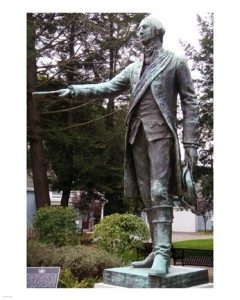Did You Know?
What makes history so interesting aren’t the words on paper, but the people who made those stories happen. Real people like you and I who simply wanted to build a better life for their family and fellow man. Here are some things you may not have known about our fair town and its history.
George Washington really did sleep here. No, not in a nice hotel room but in a primitive Fort in 1753 when he came to share a message with the French. Accompanied by his entourage, including the esteemed Christopher Gist. 
Yes, the Native Americans were also here. In fact, Pontiac’s braves destroyed the fort in 1763 as part of the French and Indian War. It was later rebuilt by the British.
Michael Hare was a brave man who fought in numerous battles during his life time plus was an Indian interpreter, weaver, teacher and more. At the age of 64 years old. He joined General Arthur St. Clair’s expedition against the Indians using his interpreting as well as soldiering skills. After scalping Michael on the field of battle in Parke County, Ohio, the Indians left him for dead where he was rescued by an Indian woman. She guided him all the way across present day Ohio into Westmoreland County, Pennsylvania where he lived at the time. She hid him by day piling branches and leaves over him, while she kept a look out from a tree nearby. He was once hidden underneath a log, which Indians in their search, had mounted for a better vantage point. Michael Hare walked 16 miles from Waterford at the age of 85 to try to enlist in the War of 1812, but was turned away because of his age at which point he walked back home. Hare died of pneumonia March 3, 1843, aged 115 yrs. 8 mo. 22 days.” We also read “Elizabeth, his wife, Died April 10 1840 aged 90 years.” Both were originally buried in the Waterford Cemetery, where a marker still remains, but later were moved to Evergreen Cemetery. In the soldier’s plot is the grave of another Revolutionary soldier, Captain Robert King, “who departed this life December 7, 1826, aged 80 years.”
Early Waterford settlers included Lieutenant Charles Martin, commander of the post, James Naylor, one of the Commissioners of Sales, Captain Martin Strong, Amos Judson,(owner of the still existing Judson House) prior to 1796. John Lytle in 1796, also Robert Brotherton, John Lennox and Thomas Skinner; John Vincent, Wilson Smith in 1797; Aaron Himrod and the Lattimores in 1798; Captain John Tracy, William Boyd, David Boyd, John and James Boyd with their three’ sisters and James Anderson in 1801-2; James and William Benson in 1804 or 5; Eliachim Cook in 1809. George W. Reed had come in by 1799, and Levi Strong and John Henry in 1812; the MeKays in 1813; and following these many of the ancestors of names still commonly heard in Waterford.
Waterford’s earliest official cemetery, located at West 2nd and West Street was abandoned about 1865. Due to the proximity of Lake Leboeuf, overflow and spring flooding would sometimes cause caskets to come to the surface and float across the Lake. Upon the opening of the new cemetery, some bodies were moved to family burial spots or other cemeteries but most remained in the abandoned cemetery. It was a subject of outrage when this abandoned area later became a source for fill dirt on town streets. In 1930, many head stones were moved to a commemorative site in the new Waterford Cemetery on the southwestern side about 1930 or before. A DAR plaque dated 1930 dedicates the site.